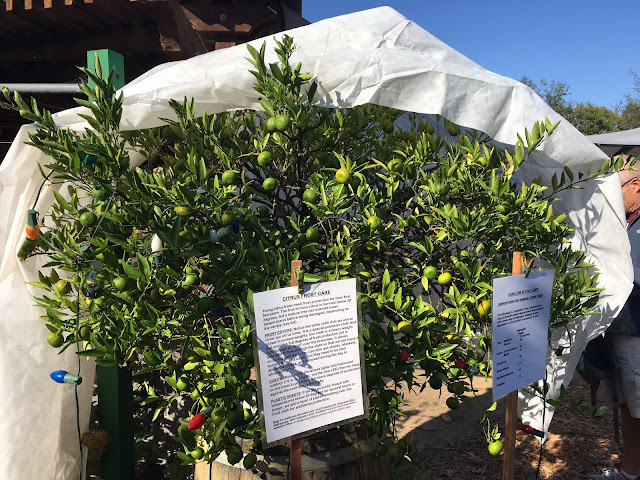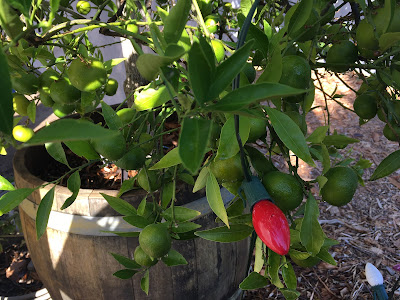
|
|
This display from the Fair Oaks Horticulture Center a few years ago illustrates how to protect
citrus trees, especially smaller ones, from frost damage. The frost blanket of course would be pulled over the tree to the ground in practice. The chart on the right is a guideline that lists temperatures below which mature citrus trees can be damaged. See the note below for details. (Photos: Kathy Morrison)
|
Time to pull out the frost blankets!
After months of expecting “possible” frost, the threat of subfreezing overnight temperatures is finally real. According to the National Weather Service, Sacramento could see 29 degrees just before dawn on Tuesday morning. That follows a very chilly night with an expected five to six hours under 32 degrees.
Frost damage occurs when temperatures stay below freezing for more than two hours. So, take precautions this evening:
* Cover your sensitive plants with frost cloth, blankets or cloth sheets (not plastic). Ideally, do this before sunset so radiant heat will help keep plants cozy.
* Remember to uncover plants during the day (especially if it’s sunny) or they can be smothered by their frost protection.
* Harvest ripe citrus that may be harmed by frost. Don't let oranges, lemons and other fruit freeze on the tree.
* Citrus trees (particularly young trees) tend to be susceptible to frost damage. Limes are the most frost-tender. Make sure they get some protection before frost hits.
* Wrap trunks of young citrus trees to insulate them from frost.

|
|
These C9 Christmas lights can help protect citrus trees.
|
* Holiday lights – the old-fashioned kind that get hot, not LEDs – can help keep plants warm, too. Wrap a string of lights around the trunk and branches. Keep the lights on all night.
* With some exceptions, keep plants watered. Frost injury occurs when ice crystals form on leaf surfaces and draw moisture out of the leaf. The damage from dehydration is what causes frost burn.
* The exception to this rule are cactus and succulents, where saturation can cause more damage. Also, such tropical plants as bananas and hibiscus may rot if over-saturated before frost, so they prefer to be kept on the dry side.
* Don’t overprotect. Plants are more frost resistant if they’ve experienced some cold weather and winter hardening.
* If frost damage occurs, wait until March or April to prune off browned branches. That injured area will help protect the rest of the plant from further frost burn.
Note: Mexican limes are the most vulnerable (29 degrees), followed by Bearss limes (28), Eureka or Lisbon lemons (26), grapefruit (25), Meyer lemons (22), sweet oranges such as navels (21), mandarins/tangerines (20) and kumquats the hardiest (19 degrees). Damage also depends on the duration of exposure to cold.

